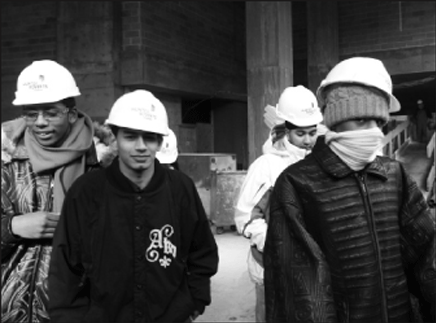By Julie Shapiro
When it’s cold and windy in Lower Manhattan, it’s even colder and windier on the just-poured concrete floors of the rapidly rising Forest City Ratner tower on Beekman St.
Joe Rechichi, a senior vice president with Ratner, stood on the tower’s frigid 29th floor last week and surveyed the progress.
“It’s not easy building a tall building in Lower Manhattan,” he said.
Rechichi has to contend with narrow streets, ancient utilities and dozens of neighboring projects competing for resources. The biggest challenge on the project so far was to convert famed architect Frank Gehry’s wavy design for the 76-story building from an idea into an engineered construction plan. Every floor of the building is different, so workers have to rebuild the concrete forms for each floor.
“It’s tough,” Rechichi said. “But when it works, it feels great.”
The Beekman tower has the distinction of being one of the few private projects that is moving ahead despite the faltering economy. Forest City closed on $680 million in construction financing last March, which Rechichi said will cover the project all the way to its completion in 2011. The building will contain the K-8 Spruce Street public school in the base, likely opening in 2011, and high-end apartments above.
Shivering alongside Rechichi on the 29th floor last Wed., Jan. 14 were a dozen students from the High School for Construction Trades, Engineering and Architecture. The students usually learn about construction from their classrooms in Queens, but last week they traveled to Lower Manhattan to see work firsthand.
At least one of the 400 workers in the tower was not happy to see students on the site. As the group headed through the ground floor, past cement trucks that spin all day long, an angry worker strode in the other direction.
“The job stops because we got people on the job?” the worker said to no one in particular. “Get the [expletive] out of here.”
The students ignored him and crammed onto the hoist, a temporary elevator that runs along the exterior of the construction. As the hoist rose, jerked, then continued rising, several students peeked nervously through the slats to see glimpses of lower buildings falling away. One girl buried her face in a tall boy’s sweatshirt.
On the 29th floor, the students huddled around Rechichi, their hands thrust in their pockets. Where walls and windows will soon appear, there was only a swath of orange construction netting separating the students from the open air and sweeping views of the Brooklyn Bridge to the east and the Woolworth Building to the west.
After explaining how each layer of concrete rises over the one below it, Rechichi led the students down to the seventh floor, where he pointed out a plywood rectangle that would become a rooftop swimming pool. Another part of the seventh floor was filled with tall crates of the stainless steel curtain wall that will soon begin wrapping the building.
“In a few months, you will be seeing it from around the city,” Rechichi told the students.
Bob Harvey, acting executive director of the Lower Manhattan Construction Command Center, helped organize the tour, which also took students down into the depths of the pedestrian tunnel construction for the Fulton Transit Center.
“You don’t have to work out in the cold,” Harvey told the freezing students at the Beekman tower. “You can be an architect or an engineer.”
Amritpal Singh, 16, appeared to take the advice to heart. While warming up in a McDonald’s after the tour, he said he had planned to be a construction worker but was surprised to see the men outside on such a cold day.
“I want to be a manager now,” Singh said. “These guys out here were all red and cold. I want to sit in an office.”
Julie@DowntownExpress.com































